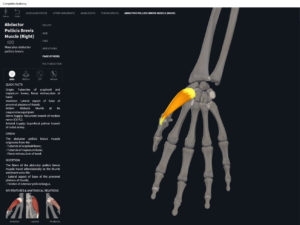Anatomy & Physiology: Muscles—Abductor Pollicis Brevis.
Structure.
- Origin: flexor retinaculum, scaphoid, and trapezium.
- Insertion: lateral side of proximal phalanx of thumb.
Function.
- Concentric action: abducts thumb at carpometacarpal joint. Lesser: thumb flexion at MCO; thumb extension at CMC and IP.
- Reverse mover action: abudction of trapezium at CMC; flexion of thumb at MCP; trapezium extension at CMC; extension of proximal phalanx of thumb at IP.
- Eccentric action: controls/restrains/slows thumb adduction at CMC; thumb extension at MCP; flexion of thumb at CMC and IP.
- Isometric action: stabilizes CMC, MCP, and IP joints of thumb.
- Innervation: median nerve.
- Arterial supply: radial artery.
Clinical Significance.
More.
- https://www.anatomynext.com/abductor-pollicis-brevis/
- https://www.youtube.com/watch?v=YIkt5uj3DrI
- https://www.youtube.com/watch?v=ZGlXpSffRyw
- https://www.youtube.com/watch?v=gUooutTt2tc
References
Biel, A. (2015). Trail guide to the body: A hands-on guide to locating muscles, bones and more.
Cedars-Sinai. (2018). Vertebrae of the spine. Retrieved from https://www.cedars-sinai.org/health-library/diseases-and-conditions/v/vertebrae-of-the-spine.html
Clark, M., Lucett, S., Sutton, B. G., & National Academy of Sports Medicine. (2014). NASM essentials of corrective exercise training. Burlington, MA: Jones & Bartlett Learning.
Jenkins, G., & Tortora, G. J. (2012). Anatomy and Physiology: From Science to Life, 3rd Edition International Stu. John Wiley & Sons.
Muscolino, J. E. (2017). The muscular system manual: The skeletal muscles of the human body.

